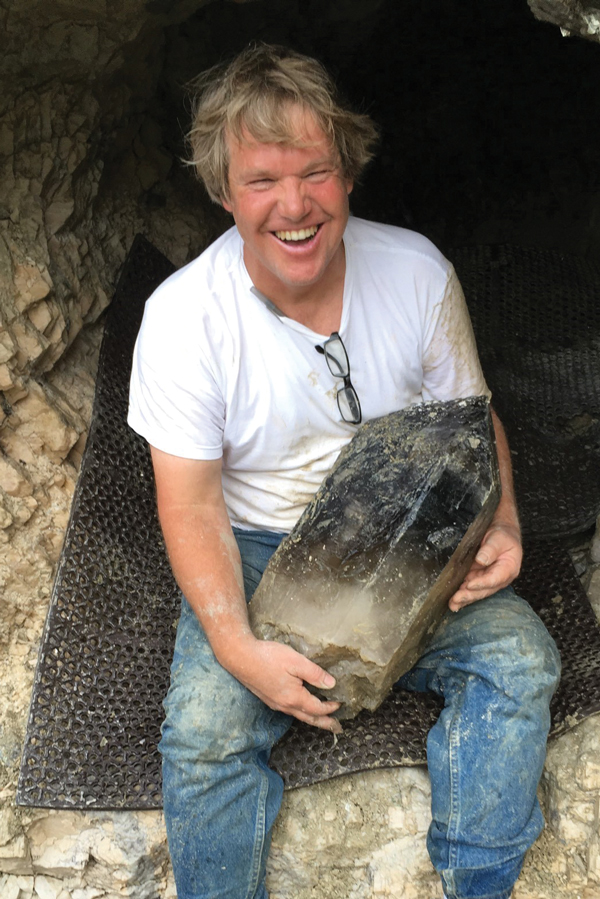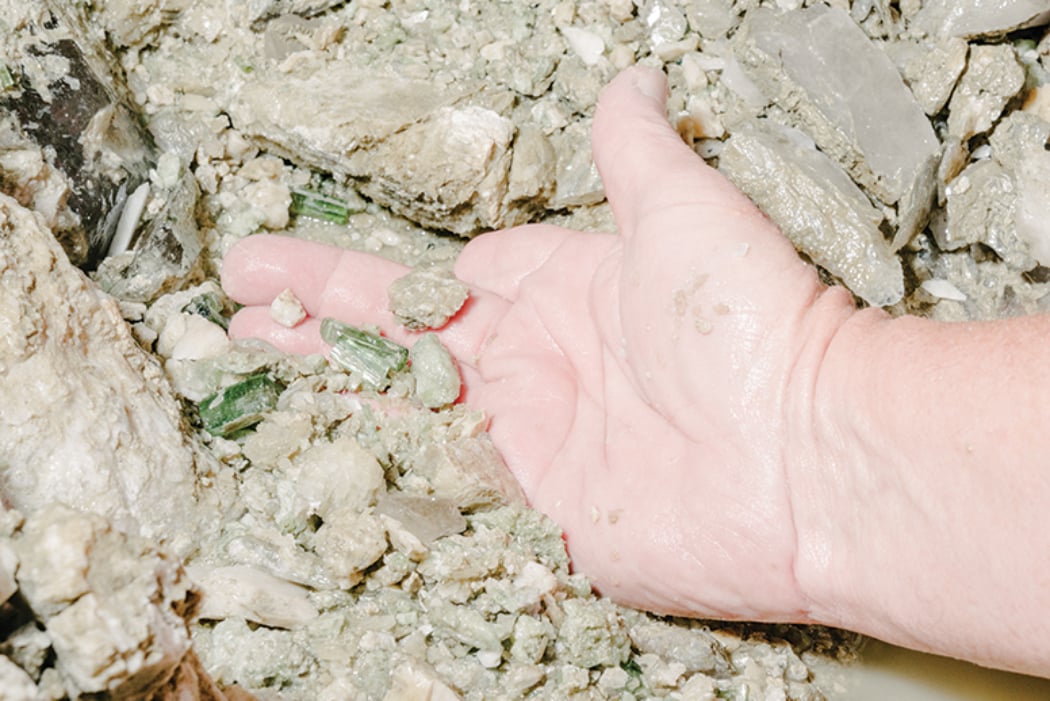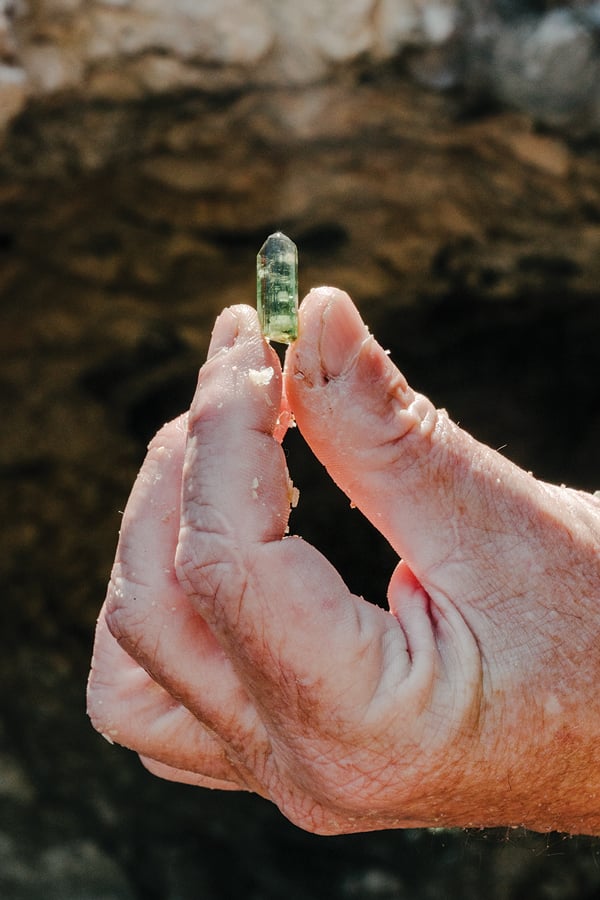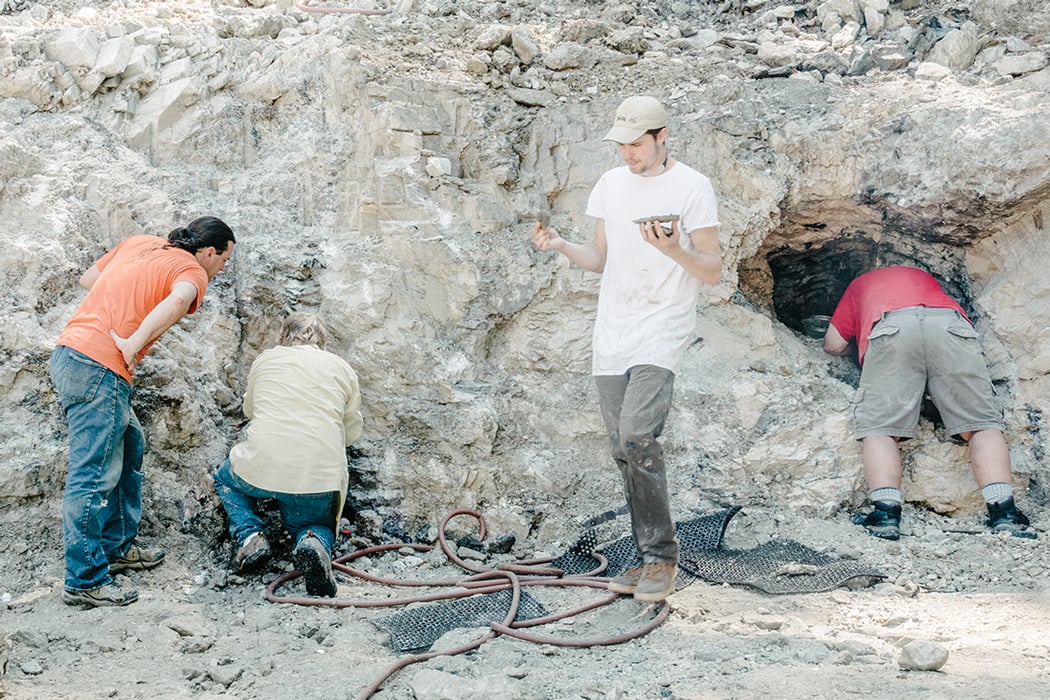Anticipation is in the air as miners dig for Maine’s state mineral (and more).
Virginia M. Wright
Photographed by Tristan Spinski

[cs_drop_cap letter=”O” color=”#000000″ size=”5em” ]n a hot, cloudless morning in the Oxford Hills, the broken terraces of Havey Quarry look bleached and overbright, like an overexposed photo. Chalky water pools in one deep corner of the pit. An excavator rests on a dusty ledge. People are gathered around a hole in the rock face, where quarry owner Jeff Morrison lies curled, hose in hand, spraying down a lumpy interior studded with Coke-bottle-green nubs. Dry, the lumpy stuff looks like stone, but it’s actually kaolin, a white clay, and as it dissolves, the green bits emerge as slender prisms, some of them 4 inches long.
Morrison scoops the crystals into a sieve and passes it out to his gem cutter, Sean Sweeney, who celebrates the mineral pocket’s first batch of tourmaline with a miner’s ritual: he holds aloft a teal rod so the sun’s rays can illuminate it for the first time since it formed in cooling magma, miles beneath the Earth’s surface, 265 million years ago.
Maine’s official state mineral/gemstone, tourmaline is the most valuable of the more than 200 mineral varieties found in the state’s granite pegmatites, mostly in the western foothills. Online, prices for raw specimens range from a few to several hundred dollars, depending on quality and size. Morrison declines to talk about the value of his finds, but says only 5 to 10 percent is gem quality or suitable for fine jewelry. He quotes West Paris mining legend Frank Perham: “If you want to make $1 million from mining, start with $2 million.”
The opening of a promising mineral pocket is an occasion at Havey Quarry. Morrison uncovered this one with a dynamite blast on a Friday the 13th, and he saw the same markers that accompanied his most-productive troves since buying the dormant feldspar quarry in 2007 — white cleavelandite, purple lepidolite, and lots of kaolin. He halted work and scheduled today’s unveiling for a few of mineralogy’s dignitaries — miners, collectors, earth scientists, a jeweler. “With these complex pegmatites, you never know what you’re going to find,” Morrison told me before he crawled into the hole. “Not everyone here is interested in the tourmaline.”
Kevin Czaja isn’t. The assistant curator of Harvard’s Mineralogical & Geological Museum, he’s patrolling the pit, eyes trained on rubble. “I’m looking for ugly, black oxidized pods that encase rare phosphate minerals,” he says. “Like landesite — it was first found and described here.”
Czaja is compiling a list of every mineral that occurs at Havey. The ones that interest him have no economic value. Instead, they offer insight into tectonic and chemical forces deep inside the Earth. “Of course,” he says, “you’re always hoping to find something new.”




Morrison and friends open the pocket and immediately extract teal tourmaline, one of several colors of the gem found in Maine. “Some of our finds are not huge, but the color and clarity is superb,” Morrison says. “Maine tourmaline competes with the best in the world.”
Ralph Pride, by contrast, is focused on tourmaline. The owner of Portland’s Cross Jewelers, he sits across from the pocket, taking notes for the gem-mining narratives he shares in his company’s ads in magazines (like this one). “Jeff has a sterling track record — the gems come out of the ground museum-case ready,” he says. “It’s the way he works, but it’s also this extraordinary location.”
Meanwhile, Morrison sprays and scratches. Sweeney ferries sieves full of multicolored gravel to Morrison’s assistant, Max Bürgi, who screens out grit and dumps the remains into buckets for later sorting. The two confer on a purple rock, agreeing it’s either lepidolite or apatite. At their feet lies a chunky piece of quartz. Bürgi points to a fracture that healed itself and sprouted new crystals. “Crystals love to try hard,” he says. “You can see how hard this one tried.”
“Ack!”Morrison backs out of the pocket, hand bleeding from an encounter with something sharp. Comes with the territory, Sweeney says, as he prepares to relieve Morrison. “Sometimes, if you’re right in the tourmaline, the pain disappears. I once opened a pocket and spent the afternoon clawing things out. Later, I looked at my fingers. The nails were basically gone.”
Morrison wraps his hand and takes a seat. Czaja approaches with a knobby elongated rock — a pod! “Maybe it’s jeffmorrisonite,” he jokes. He’ll take it back to his lab, break it open, and look for microcrystals. “As ugly as this thing is, under the microscope, it could be more beautiful than you can imagine.”
Morrison looks skeptical. “When they start looking for that stuff,” he says, “you know they’re weird.”




